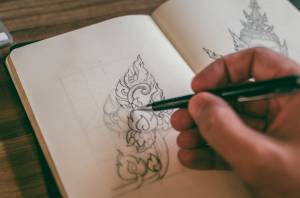Pencil shading is a technique used to create the illusion of depth, texture, and form in a drawing. Here are some tips to improve your pencil shading skills:

- Use a range of pencils: Different pencils have varying degrees of hardness and softness, which produce different tones. Use harder pencils (H-grade) for lighter shades and finer details, and softer pencils (B-grade) for darker tones.
- Understand light and shadow: Study how light falls on objects and creates shadows. Observe the direction of the light source and how it affects the subject you are drawing. This understanding will help you determine where to place highlights, mid-tones, and shadows.
- Start with light pressure: Begin shading with light pressure on the pencil to create a faint outline or initial layer. This allows you to make adjustments and corrections easily as you progress.
- Build up layers: Gradually layer your shading by applying more pressure on the pencil. Multiple layers of shading create richer and smoother tones. Vary the direction and angle of your strokes to achieve a more organic look.
- Use a variety of techniques: Experiment with different shading techniques to achieve various effects. Some common techniques include hatching (parallel lines), cross-hatching (overlapping lines), stippling (dots), and blending (smoothing out tones using a blending tool or your finger).
- Pay attention to highlights and reflections: Highlights are the brightest areas where light directly hits an object, while reflections occur when light bounces off a nearby surface. Leave these areas lighter by shading around them, or use an eraser to lift off some graphite to create highlights.
- Practice values and gradients: Mastering the skill of creating smooth transitions between light and dark areas is crucial for realistic shading. Practice creating gradients by shading from light to dark or vice versa, ensuring a seamless transition between tones.
- Study reference materials: Observe and study photographs, artworks, and real-life objects to understand how different textures, materials, and surfaces are shaded. This will help you develop a better understanding of how light interacts with different subjects.
- Use appropriate paper: Choose a paper with a suitable texture for your shading techniques. Smooth paper allows for more even and precise shading, while textured paper can add an interesting effect to your drawing.
- Practice regularly: Like any skill, pencil shading improves with practice. Set aside dedicated time for regular practice sessions, and challenge yourself with different subjects and lighting conditions to expand your abilities.
Remember, patience and perseverance are key when it comes to pencil shading. Keep practicing, experimenting, and refining your techniques, and you’ll see improvement over time.
The Art of Pencil Shading: Tips and Techniques for Creating Depth and Realism